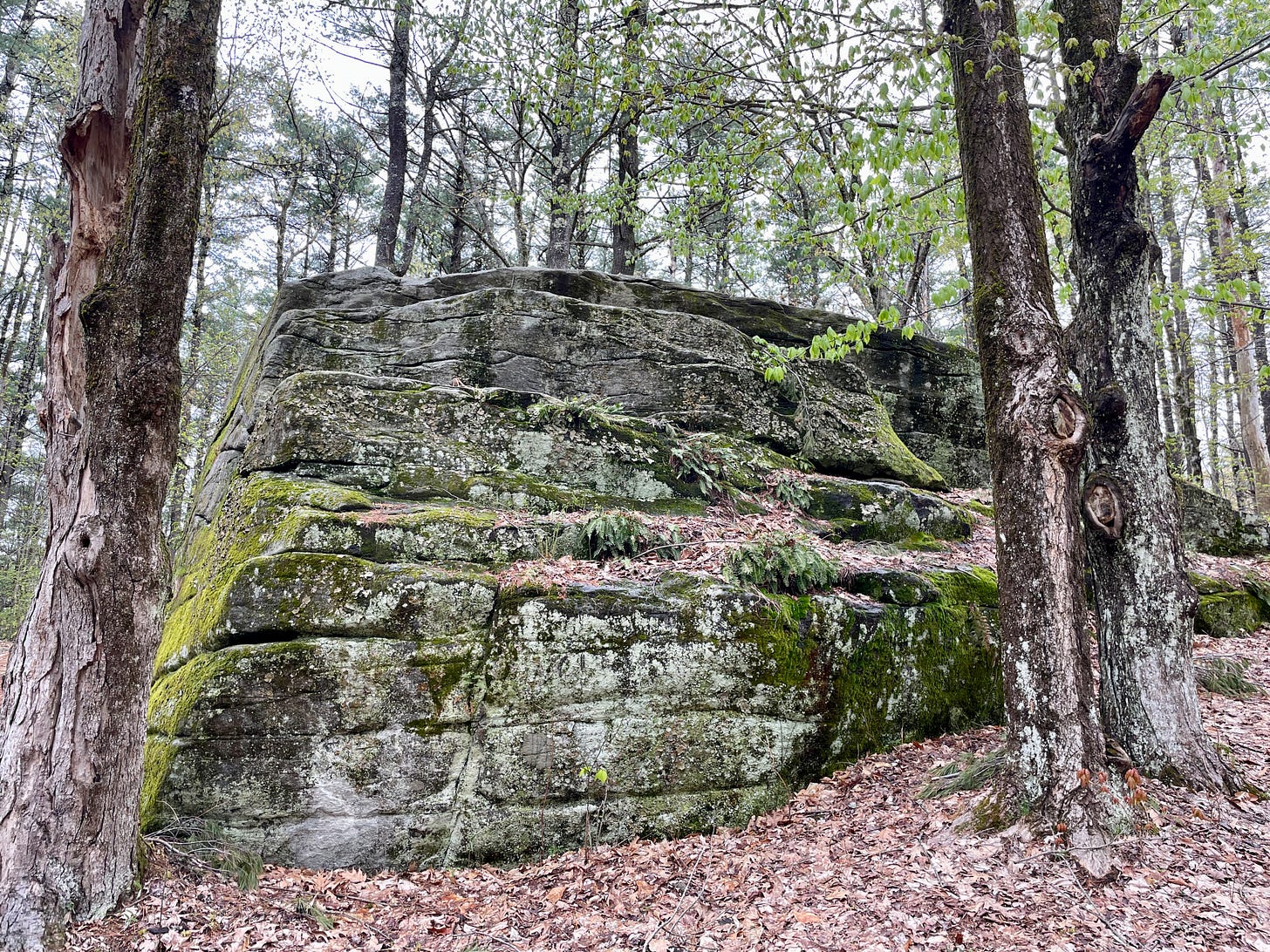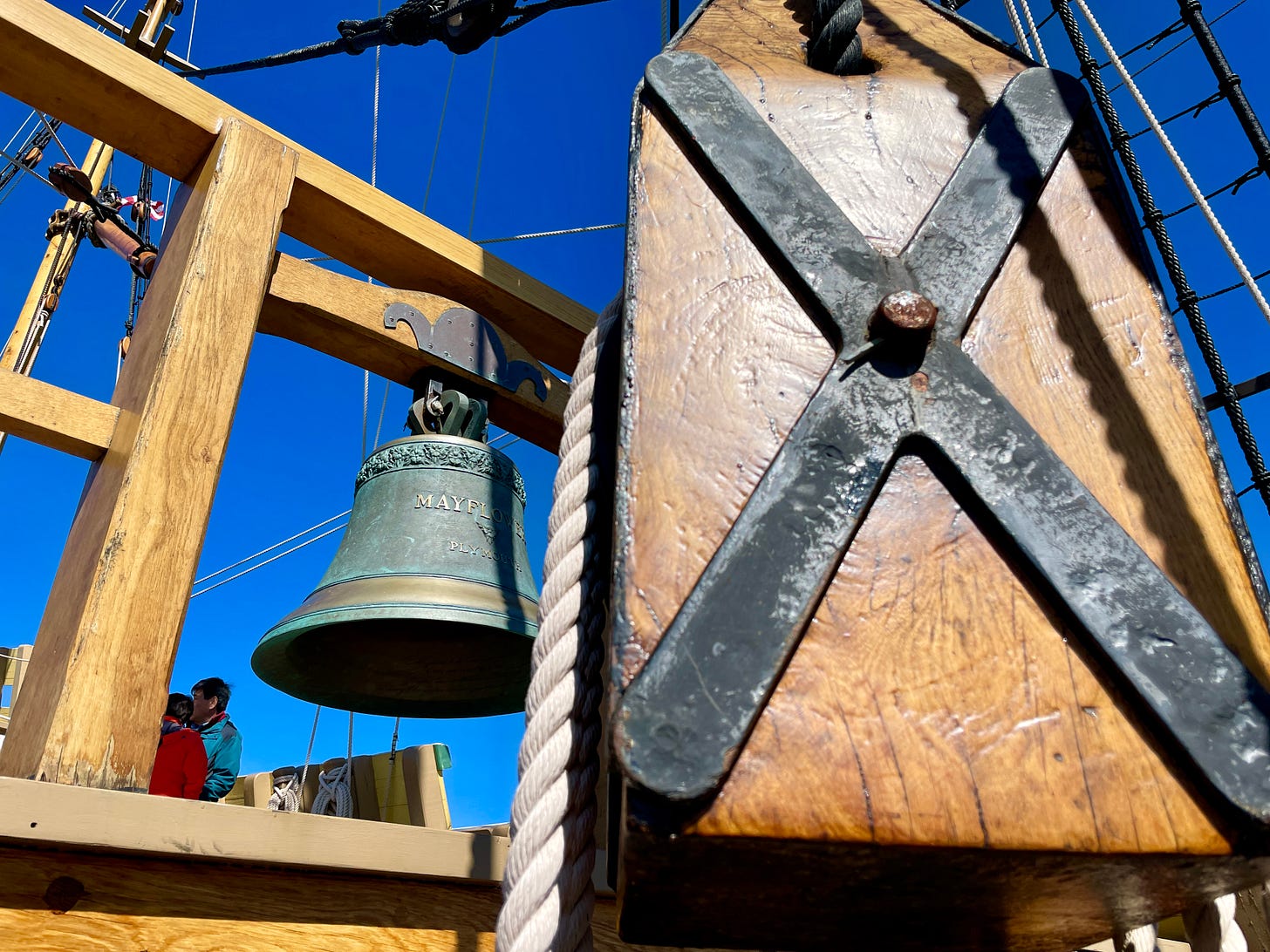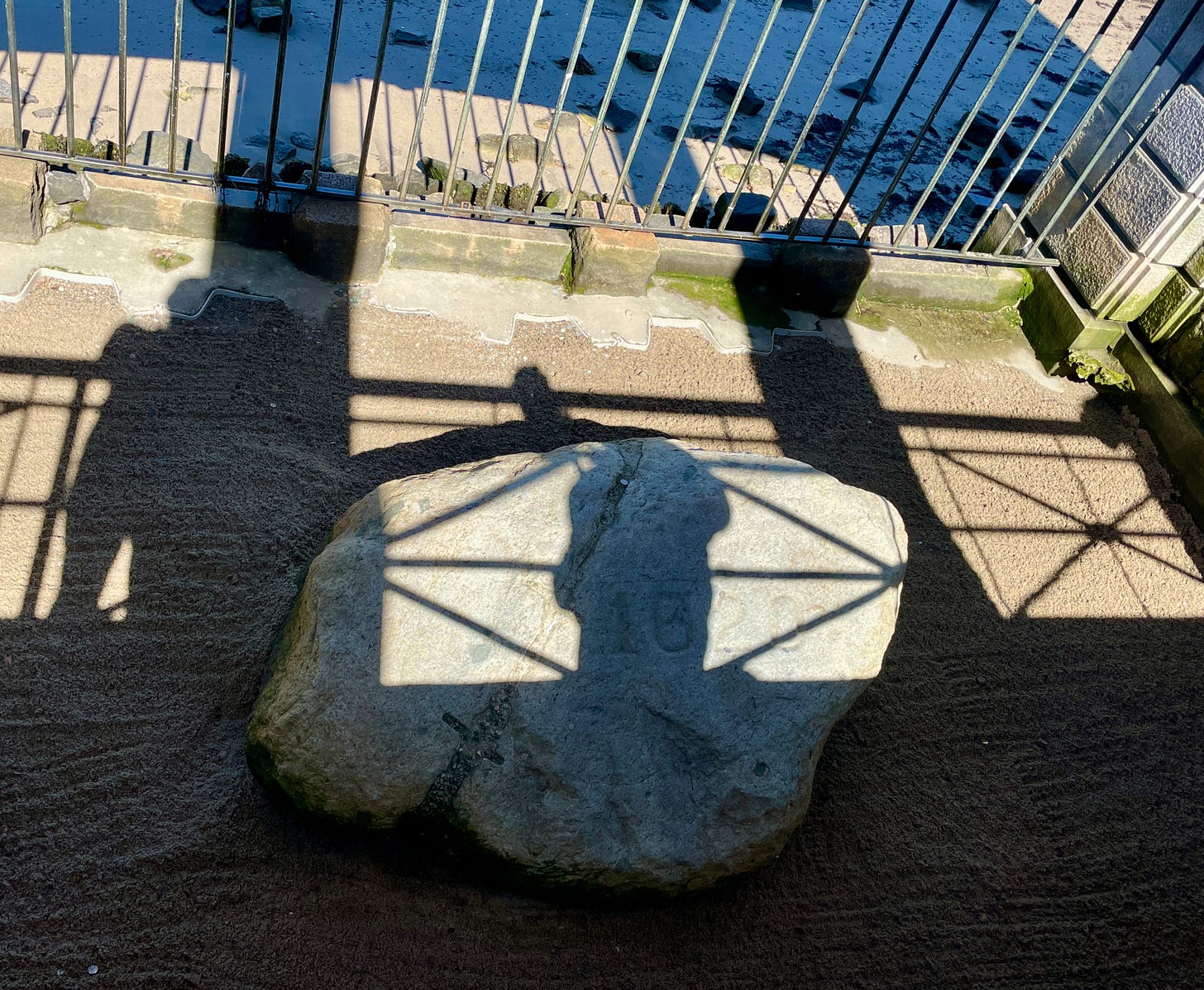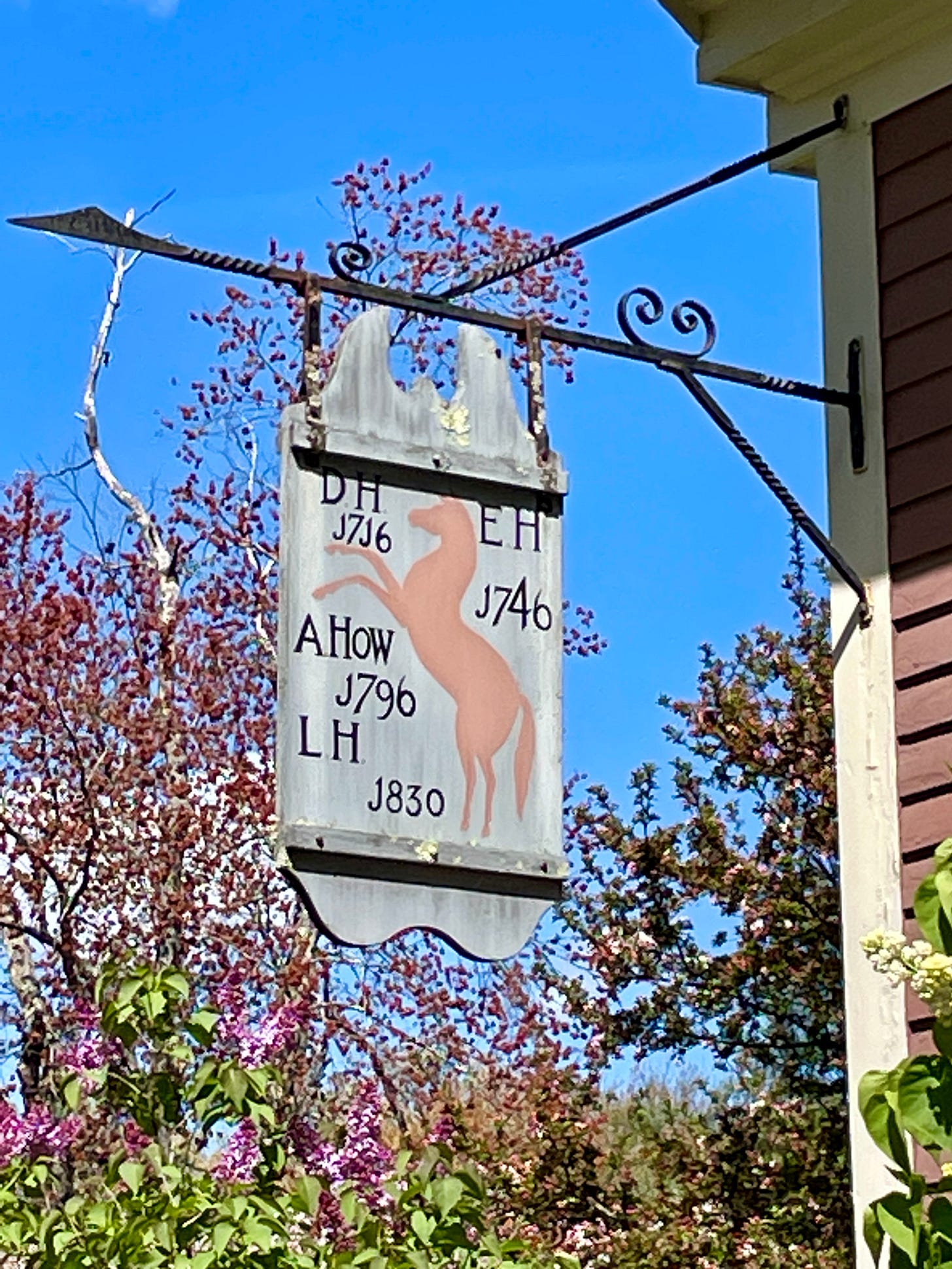Chasing Ancestors
Missing parson's notes, two rocks and a ship, and an occupancy question at a historic inn.
1)
I’ve always collected obsessions. As a little kid I was a dinosaur fanatic and then a baseball rooter and a Star Wars disciple. I left the first one behind; the other two have never let go of me. As a tween my life was dominated by Dungeons & Dragons; I moved on from there to become a rock music aficionado/bore. As an adult, I somehow became an exacting, obsessive maker of custom baseball cards … and a self-taught genealogist.
Genealogy comes with an added challenge: It’s devilishly hard to write about, partially because the narratives are mostly about the discovery process and partially because it’s a little like fantasy baseball in that no one cares about anybody else’s team. I’ve never quite cracked this nut, though I keep trying (and wondering what John McPhee could do with it, but that’s another post). One day perhaps I’ll succeed.
My latest family-history quest took me across a swath of Massachusetts, looking for information about my ancestor Moses Gilbert and his forebears.
Moses is a relatively recent genealogical discovery, the father of Mrs. Jehial Allen, introduced that way because for years all I had about her was a vague, unsourced appellation from an Ancestry family tree: Betsy G. A couple of years back, a wedding announcement in the Randolph (Vt.) Weekly Wanderer finally revealed Betsy’s last name: Gilbert. That led to her father Moses and his wife Isabella.
Moses Gilbert was born in 1745 in Brookfield, Mass., the son of David Gilbert and Hannah Abbott. He was a carpenter, moving around various towns in western Massachusetts and Vermont before dying in Kingsbury, N.Y., in 1822. A biography of Moses in a 1953 Gilbert family history summarized his will (excellent) with no mention of a Betsy (oh no), but you should always check the original documents: It turns out “Betty Allen,” who by then was probably dead, is indeed mentioned in the will, with her father explaining that his Allen grandchildren were getting nothing because he’d done all “that I think I ought to do” for their parents.
Case closed, but breaking down a genealogical brick wall always reveals more to smash away at.
Moses Gilbert’s line goes back to the earliest days of colonial New England, and proved relatively easy to trace. That was no surprise: New Englanders kept good records and then went on a self-aggrandizement/anti-immigrant kick in the 1800s, with families proudly researching and documenting their connections to the Mayflower (optimal) or at least some other Great Migration arrival.
Isabella, however, has proved a mystery. Some family trees claim her last name was Denny, and there’s a notable Denny family from Leicester, Mass., a couple of towns east of Brookfield. But I can’t find a connection with those Dennys and Isabella; nor can I find any link to a Persis Denny who married Ruben Gilbert, Moses’s first cousin, about the same time.
But the same family history that was a bit sloppy about Moses’s will offered another piece of information: In 1774 Moses and Isabella owned the baptismal covenant for the Church at Oakham. That came from a book listing soldiers from Oakham who’d fought in various wars, and which gave baptismal dates for Moses’ and Isabella’s first two children, citing “the Rev. J. Dana’s notes.”
Enter Josiah Dana of Pomfret, Conn., chosen in 1767 by the people of Barre, Mass., to be minister of the First Parish Church, a post he remained at until his death in 1801. 1992’s The History of Barre: Windows Into the Past observes that Parson Dana’s “well-written and carefully expressed records survive today and serve to point out the weaknesses and foibles of the townspeople of the eighteenth century,” with an approving aside about his “neat, sand-blotted writing.”
That was intriguing on several levels. Genealogy can be a fight to the death between modern eyes and historical handwriting (don’t even get me started on German old script), so a colonial record in a neat hand is a godsend. Parson Dana recorded the baptisms of the first two Gilbert children. Given Moses’ role in baptisms, the two men’s spheres overlapped. And as far as I could tell, Parson Dana’s notes had never been digitized. What else might they reveal about Moses or the mysterious Dennys?
The first question, then, was what had happened to those notes. Which led me to Barre, and the brief window on Thursdays when its historical society is open.
And, it turned out, further questions.
The historical society didn’t have Parson Dana’s notes, and the principal author of The History of Barre was long dead. From there, the trail vanished into thickets and tangles all too common in genealogy.
After Parson Dana’s death, the First Church of Barre (along with all of New England) was riven by a schism between conservative Congregationalists and the more liberal Unitarians. (The key sticking point was predestination, and the question of whether someone’s acts in life could be their salvation.) The split led to multiple churches in Barre with confusing names. Which one had wound up with Parson Dana’s records?
It was probably the Unitarians: A 1970 inventory of church records by Harvard Theological Studies adds a (U.) to its entry for the First Church of Barre, and says Parson Dana’s records and a manuscript copy of them made in 1898 were “owned and held by the church.” Except as they told me in Barre, the Unitarians haven’t had a congregation there in decades, and the church was razed in 1969. The author of The History of Barre obviously saw Parson Dana’s notes, but where?
Another issue is shifting town borders: Moses is variously recorded as of New Braintree and Oakham. Oakham and Barre are neighbors, and both began as districts of nearby Rutland, with Oakham established in 1762 and Barre in 1776. Old records can make it look like people are moving when what you’re really seeing is town and county boundaries appearing and shifting around them. Now throw in churches: Parson Dana was based at Barre but was the “clerk” for the Congregational Church at Oakham from 1773 through 1779. He probably came to town every so often to baptize children and otherwise tend to what was something of a satellite flock.
I’d imagined getting to sit down with Parson Dana’s notes and their never-before-digitized secrets. That didn’t happen. But even when the hunt proves fruitless, you may find other things of value.
I spent a couple of hours criss-crossing Barre’s pretty common, walking back and forth between the historical society, the Congregational church and the library while chasing leads on my cellphone. A woman I talked with on one of those calls was kind enough to track me down in the library, telling me that she’d been the editor of The History of Barre. (“Nobody let me edit anything,” she added wryly.) She became intrigued by the puzzle and we’ve exchanged emails since then, giving me an ally who’s a heck of a lot closer to Barre than I am.
There’s also a quiet satisfaction in seeing places your own people once knew. In my early years as a genealogist I fell into the bad habit of seeing ancestors as baseball cards, less people than assemblages of photos and dates. Born, married, died, here’s a snapshot of a listing tombstone, my work is done. I still try and track down those basics, but I’m much more excited when I can find a photo, a letter or an object that’s been handed down, get a glimpse of what someone’s world was like, or stand in a place where that person stood.
I likely carry bits of DNA inherited from Moses and Isabella, little snippets of genetic code that have been copied seven times during a 200-year journey across Massachusetts, New Hampshire, Ohio, Montana, California and Virginia. So far Parson Dana’s notes remain elusive, but it still made me happy to stand outside the Congregational Church in Oakham and think that I’d brought traces of Moses and Isabella back to a place they knew.
2)
I’d kept a day free in case my hunt for Parson Dana’s records paid off; when it didn’t, I was at loose ends and decided to play tourist.
My first stop was Redemption Rock in Princeton, the site where Mary Rowlandson’s freedom was negotiated in 1676, after her 11 weeks held captive by Metacom’s warriors during King Philip’s War.
That conflict, all but forgotten today, fascinates me — “King Philip,” AKA Metacom, son of the sachem whose friendship had been so critical to the Plymouth pilgrims, led an uprising against the colonists that included attacks on nearly half of New England’s towns. Western Massachusetts was essentially depopulated, as was the outermost “rings” of settlement beyond Boston. Few families were untouched by the war: nearly 10% of military-age men available for military service lost, houses and farms burned and livestock slaughtered. (It was, of course, far worse for Native Americans, who were massacred, sold into slavery and broken as a New England power.)
Rowlandson’s captivity was a small part of that story, but one with an outsized impact — her account of her captivity and redemption was a publishing sensation on both sides of the Atlantic, and arguably marks the dawn of modern American publishing. And it’s a good story, always compelling and sometimes startlingly insightful about her captors in ways that might surprise you.
I’m no kin to Rowlandson, but King Philip’s War touched many of my ancestors, including two who played important roles in the campaign. My 11th-great grandfather Michael Pierce was the commander of a colonial force ambushed and wiped out by Narragansetts in Rhode Island; Pierce died along with most of his men, with nine soldiers who survived the ambush soon wishing they hadn’t, as the Nine Men’s Misery memorial commemorates the site where they were tortured to death. Then there’s Benjamin Church, my first cousin 11 times removed: Church was Pierce’s opposite in the annals of the war, working closely with Native American allies and emulating their tactics. Church was both a canny warrior and a savvy diplomat; it was his company that ran Metacom down in the swamps of Rhode Island, and he’s considered the father of the Army Rangers.
After visiting Redemption Rock, I put right a long-ago tourist misfire by heading for Plymouth. I’d been there a few years ago, enjoying a visit to the Plimoth Patuxet Museums and picking up Nick Bunker’s wonderful Making Haste From Babylon. But when I visited then, the Mayflower II was being overhauled for 400th anniversary celebrations. After a little Googling revealed that you could tour the ship again, I knew what I’d do with the rest of my day.
The Mayflower II is a reproduction and not a replica, as one of the guides pointed out — the difference being that a replica is based on blueprints while a reproduction involves guesswork. (Hey, now you know!) Even on a nice spring day, it was cramped and cold belowdecks, and I tried to make myself imagine my surroundings with a lot less light and far more people, not to mention all their supplies and effects and a large number of animals. It would have been claustrophobic and pestilent, to say the very least.
After that I strolled down to Plymouth Rock, because why wouldn’t you? “Ah yes, the most disappointing point of interest in Massachusetts,” a friend of mine cracked on Twitter after I tweeted out a picture of the rock with the caption “Yeah, bullshit.”
Plymouth Rock is indeed bullshit — ahistorical schmaltz that would have baffled any of the actual colonists. But regarding the rock amid a gaggle of similarly underwhelmed tourists, I thought to myself that it was very American bullshit — a complicated, fascinating story sanded down to legend and souvenir hunting, yet a rewarding one for all that if you’re prepared to put in the work.
I was at Plymouth as a tourist and not a genealogist: I followed my visit by stopping off at the Lynwood Cafe, the axis mundi of South Shore bar pizza — Massachusetts’ extremely local food traditions deserve more attention. But as it happens, I do have family connections to the Mayflower — passengers Richard Warren and Francis Cooke are my 11th great-grandfathers, and Francis’s son John (who also made the journey) is my 10th great-grandfather.
I’ve never found that particularly impressive — there are about 10 million Mayflower descendants in the U.S., and the Warren line is one of the more common ones for connections, as all seven children survived to adulthood and had children of their own. (According to Wikipedia, my Warren cousins include the aforementioned Benjamin Church, who was Richard’s grandson, as well as the likes of John Cena, Taylor Swift, Grant, FDR and [whoops] Sarah Palin.) Nor have I ever bothered with trying to join one of the societies of Mayflower descendants, which by all accounts is mostly a testament to one’s ability to plow through paperwork.
Still, there I was more or less where my Warren and Cooke ancestors had been, so I snuck down to the beach with a hammer and a chisel and broke off a little piece of Plymouth Rock in their honor.
Just kidding. Don’t do that, even if Plymouth Rock is bullshit.
3)
I had one more item on my family-history to do list: I wanted to spend the night at the Wayside Inn in Sudbury.
The inn, located on the old Boston Post Road, dates back to 1716 and has a storied history: Longfellow made it famous in an 1863 book, and Henry Ford owned it in the 1920s, turning it into a sort of proto-Disneyland. Among other things, Ford constructed a new grist mill which his pal Thomas Edison used for experiments with motors and added the schoolhouse attended by the little girl from “Mary Had a Little Lamb” (betcha didn’t know that was a real thing) to the property, having bought the building and moved it from the town of Sterling.
I knew none of that before I came to the Wayside Inn; that wasn’t why I was there. I came because of family history: David Howe, who opened the current inn in 1716, is my 9th great-granduncle; his father Samuel and grandfather John also ran taverns in the area. Samuel’s house was burned down in King Philip’s War; to bring us full circle, Samuel’s daughter Mary was Moses Gilbert’s great-grandmother.
Sometimes you get more family history than you anticipate. I was given Room 9, which resembles a ship’s cabin more than a modern room and is accessed, Harry Potter-style, through an unmarked door in the inn’s museum. Putting down my bags, I noticed there were dozens of notes stuffed beneath the beams of the ceiling, many of them mentioning someone named Jerusha.
A little Googling revealed the tale: Room 9 had been the bedroom of Jerusha Howe, sister of the last Howe innkeeper. The story goes that Jerusha was engaged to an English visitor to the Wayside Inn; he returned to England to put his affairs in order before marrying her but was never seen again. Jerusha, it’s said, haunts her old bedroom pining for her lost love, making herself known through late-night piano music, an unexpected hint of orange blossom perfume and — on occasion — spooning with male visitors. (Further Googling revealed “spooning” to be something of a euphemism.)
I was intrigued, not just by the idea of a ghost but also by the etiquette questions raised. If you’re in a haunted room in an inn, how do you conduct yourself? Do you apologize for farting? Are certain precincts of the internet even more frowned upon than usual?
Thinking about it a bit more, I decided if Jerusha had really been hanging around a hotel room since 1842, she’d be pretty hard to shock. I also did some quick work with my family tree after realizing something that probably occurred to you already. Once I had the answer I smiled: Jerusha and I were third cousins eight times removed.
Morning arrived with no instances of piano music or unexpected perfume, to say nothing of spectral hanky-panky. As a skeptic whose interests run more to science than superstition I was relieved; as a storyteller and genealogist, I admit to being a little disappointed. It would have been fun — and a unique form of research — to talk family history with a ghost who’s also a relative.





